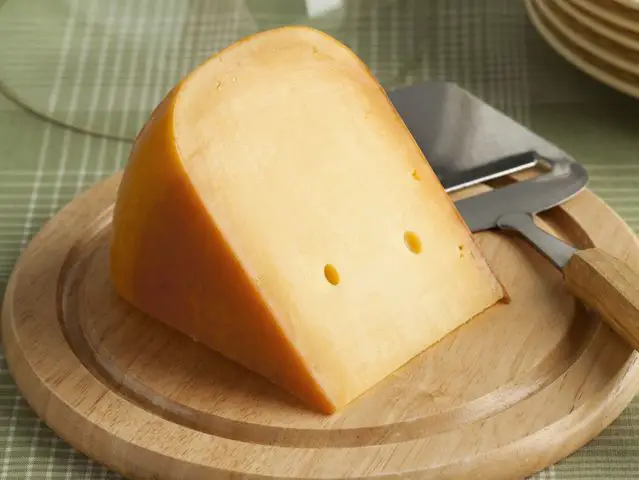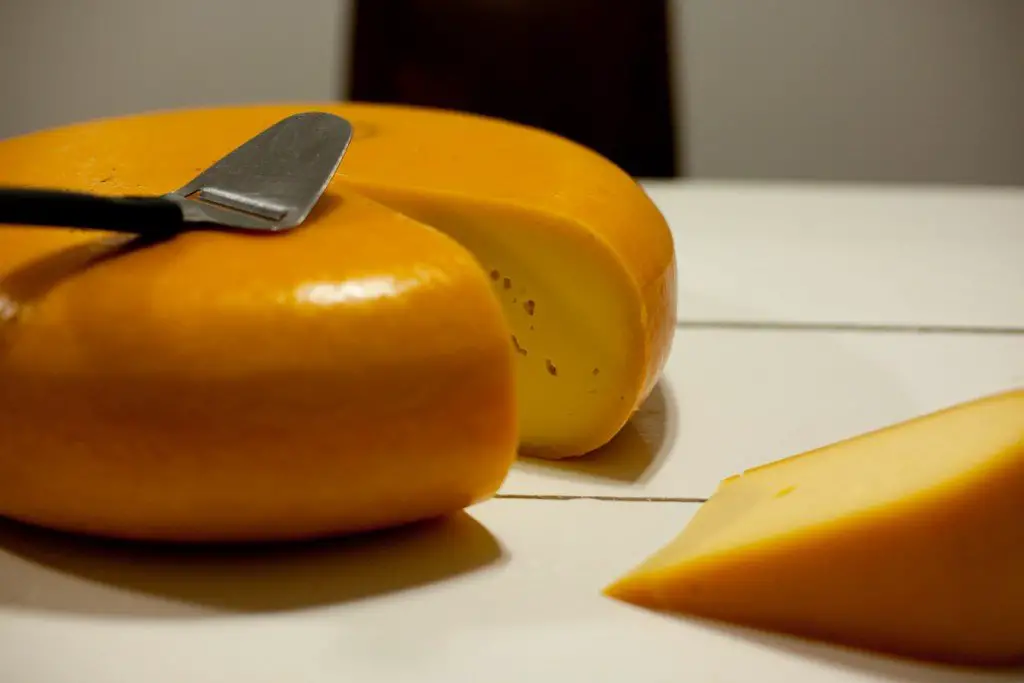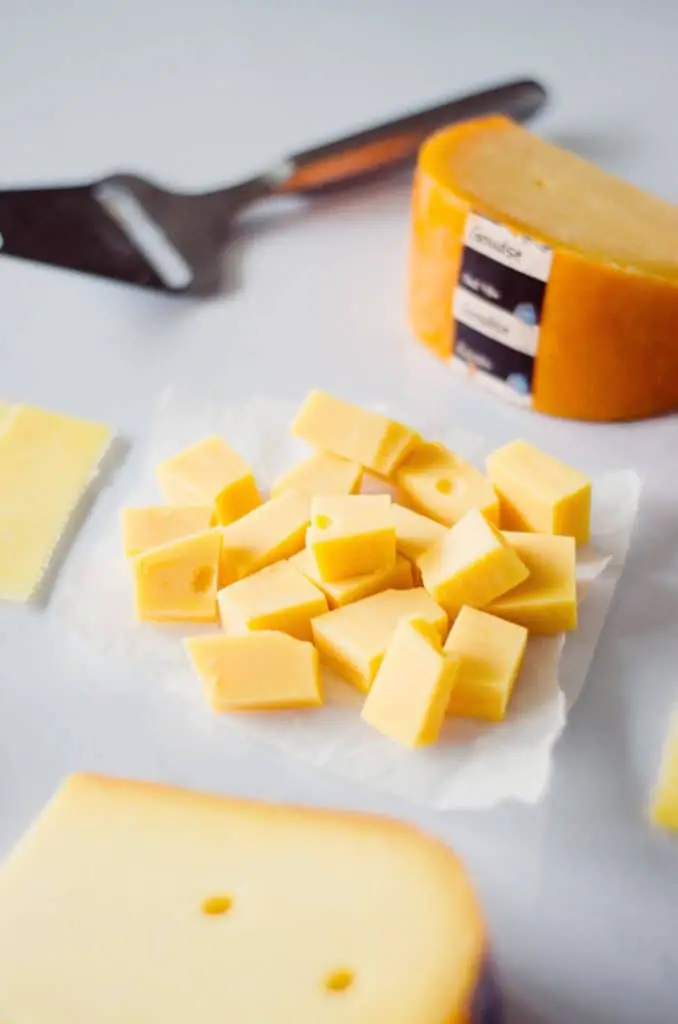What Are Cheese Cultures
Cheese cultures are a group of specific bacteria strains that are combined in order to make a particular type of cheese. They are also used to help good bacteria in the milk flourish and lead to a more rich and developed flavor. All cultures accomplish the same basic task–their primary function is to raise the acidity of milk by absorbing the lactose and transforming it into lactic acid. This part is especially beneficial in the cheesemaking process for three reasons:
How Is Gouda Cheese Made
To make Gouda cheese, cheesemakers mix whole milk with bacteria and rennet. The curd solidifies into a gel before undergoing a double cut .
The double cut helps retain fat this is part of what gives young Gouda its meltable texture. Then, curds are molded and washed with hot water before pressing.
Washing removes some of the lactose, which is the substrate that bacteria convert to acid. Removing it results in a sweeter, less acidic cheese when the aging process has finished.
Cheesemakers press the cheese, then brine it with a solution of water, salt, and vinegar for a few days before it undergoes aging.
Many styles of Gouda are covered in a layer of cheese wax to prevent the cheese from drying out during its aging period. Traditionally, Gouda is coated with red or yellow cheese wax.
Some styles, like Boerenkaas , are simply brushed or wiped periodically to maintain a clean rind.
Gouda Cheese Everything You Need To Know
We may earn commissions from qualifying purchases at no extra charge to you. For more information, check out our Disclaimer.
One of the oldest surviving varieties of cheese, Gouda has been in continuous existence since at least 1184. It is highly valued for its rich, caramelly flavor conferred by the grass where cows graze in the valley.
Over 300 farms in the Netherlands still make Gouda using old-fashioned production methods. Still, it also exists in modern, industrialized forms, which have popularized it across Europe and the United States.
Below we’ve outlined our comprehensive guide to everything gouda. Leave a note at the bottom of the page if you have any questions/comments.
Don’t Miss: Philly Cheesesteak Pizza Ingredients
What Is It Used For
Gouda is a great melting cheese. I like to combine some with cheddar for mac & cheese. It works well on any cheese board. I sampled some recently along with some relatively mild cheeses and it went really well. I also have heard that it works well in cheese soups.
Smoked gouda is great for sandwiches, mashed potatoes, and most certainly burgers.
Gouda can be used to make grilled cheese sandwiches.
RELATED – Does Gouda Cheese Melt?
How To Cut Gouda Cheese

Gouda cheese is an excellent addition to a beautiful cheese platter because of its original orange color. It brings up color and a touch of pep to the visual. Moreover, as far as we know, it is a cheese that generally pleases most people.
To cut gouda properly, we recommend you use a sharp knife without teeth. It is imperative to respect the heart-rind rule when cutting this cheese. Of course, if you are fond of this dairy product, you can cut it in classic pieces, it is not forbidden! The golden rule remains: you treat yourself and please your guests.
You May Like: Do Babybel Cheese Melt
What Is Gouda Cheese
A semi-hard cows milk cheese from the Netherlands, Gouda has a dense texture, orange color, meltable crumb, and very few eyes. Its flavor is reminiscent of nuts and caramel.
The name Gouda is not protected in the same way as other varieties, like Camembert or Brie, defend their names. However, traditional production methods define Gouda as a style, although the degree of aging produces significantly different results.
Another customary aspect of Gouda is its shape although wheels as large as 176 lbs may be molded, they always appear as wide, flattened wheels.
Beemster: Cheese From Below Sea Level
This cheese combines two undeniably Dutch things: the iconic dairy product and almost being underwater.
Beemsterkaas has a similar production style to Gouda, but the difference is in the milk. Specifically, beemster cheese is made from milk from cows who eat grass grown on a sea-clay polder four meters below sea level. Fancy, right?
Because of the cows special diet, the cheese made from that milk has a unique flavour. The cheese has a particularly sharp, salty flavour because of its extensive ageing times. Talk about artisanal!
You could slice beemster for a sandwich, cube it for crackers or by themselves, and it pairs nicely with ports and red wines.
Where to buy: All Dutch supermarkets, cheese shopsPasteurised: YesAging time: Two months to two years
Read Also: Private Selection Hard Salami
Everything You Need To Know About Dutch Gouda Cheese
14.06.22
Gouda is a Dutch cheese that belongs to the uncooked pressed cheeses type. It is probably the most popular cheese in the Netherlands, along with Edam. This dairy product is made from pasteurized, skimmed whole cows milk. We recognize it thanks to the distinctive orange color of its rind, although other types of Gouda exist. Indeed, we can find this cheese with a white rind, a yellow rind and even a red rind. You didnt know that, did you?
In this article, the experts from Paroles de Fromagers tell you everything you need to know about gouda cheese. Lets learn how to store it properly, how to pair it, how to cut it and much more Here we go!
How Gouda Cheese Is Made
Raw or pasteurized milk is heated, then cultures are added to begin fermentation and acidify the milk. Next, rennet is added to coagulate the milk into a gel-like curd. The curds are cut to expel whey and reduce moisture.
Two key characteristics of Gouda are that it’s sweet-tasting and low in moisture, and the next steps create these attributes. The curds are scalded with hot water and stirred these techniques expel moisture from the curds. Then the whey is rinsed away, taking much of the lactose in the cheese with it. Because that lactose won’t break down into lactic acid during the aging process, the result is a sweeter-tasting cheese.
The curds are then hooped into large circular molds and pressed to remove even more moisture. The wheels are then soaked in a salt brine before a thin coating of food-grade wax is applied, giving the cheese its signature shiny, colorful exterior. The wheels are then placed in the cheese cave to age for anywhere from a few months to several years. High-quality, long-aged wheels may develop crystals of tyrosine, an amino acid, or calcium lactate, a byproduct of the breakdown of lactose into lactic acid.
You May Like: Charcuterie Cutlery
Goudse Kaas: The Dutch Staple
Ah yes, the classic Dutch cheese and no, it doesnt refer to golden cheese
You probably know Goudse kaas by its English name: Gouda. This particular cheese comes from the city of the same name in South Holland.
Gouda has a mild nutty and almost tangy flavour, with a fudgy texture. The cheese pairs great with dessert wines and fruits, but its also the standard cheese for a boterham .
Historically, farmers and merchants traded the cheese in this region, but now, its the catch-all phrase for Dutch cheese varieties made in a similar style.
Fun fact: this cheese was so good French soldiers would steal it from Dutch farmers in the 19th century.
Where to buy: All Dutch supermarkets, cheese shops, Gouda cheese marketPasteurised: Often, but can be made with unpasteurised milkTexture: Semi-hard to hardAging time: One month to three years
Gouda Holland Pgi / Noord
The protected geographical indication and protected designation of origin protect the names of products that have unique characteristics linked to their geographical origin.
Gouda Holland PGI is a naturally matured, semi-hard cheese produced from the milk of cows that graze on Dutch dairy farms.
Noord-Hollandse Gouda PDO is a less salty variety of cheese, and is prepared solely from milk obtained in the Province of Noord-Holland.
Recommended Reading: Does Babybel Cheese Need To Be Refrigerated
Different Kinds Of Gouda Cheese
- Oplegkaas: This is the only type of Gouda with PDO restriction. It is made from pasteurized cows milk and must be aged a minimum of two years.
- Boerenkaas: Boerenkaas is an artisanal variety of Gouda made from the unpasteurized milk of cows grazing on low valleys in the Netherlands. The farmers who manufacture these cheeses must follow strict traditional production rules.
- Gaskaas: This young Gouda is made from pasteurized milk and aged just a few weeks before it is considered ready to consume
- Overjarig: Aged 5 years or more, Overjarig develops tyrosine salt crystals and a rich flavor like toffee.
- Jong, Jong belegen, Belegen, Extra belegen, and Oud: Between Gaskaas and Overjarig are five additional types of Gouda, categorized according to the length of their aging time and the corresponding strength of flavor and firmness of texture.
What To Pair With Gouda Cheese

Besides eating Gouda cheese with fruits, bread, or crackers, Gouda cheese is also an indispensable drinking bait. Below are some recommended alcoholic drinks that pair well with Gouda cheese.
The taste of Gouda cheese amplifies with age. Thus, each type of Gouda matches with different types of drinks. Look at this table for more specific information.
| Types of Gouda cheese |
|---|
| Peated Scotch, Peated Whiskey |
Don’t Miss: Private Selection Genoa Salami
Where Does Gouda Cheese Come From
Although Gouda is named after a city in Noord-Holland, it probably didnt originate there. Instead, the town of Gouda was the center of a vigorous cheese trade in the Netherlands and enjoyed a monopoly over the cheese trade, including the cheese to which it would give its name.
Local traders, often in traditional costume, still travel to Gouda to have their cheese weighed and priced.
Culinary Use Of Gouda
The characteristics of Gouda assign its generous destiny as a main course cheese. Like other similar cheeses, Gouda goes very well with other fruits and nuts. You are free to grate more mature Gouda on a salad, but to use soft for making sauces and dressings.
Each sandwich prepared with the addition of this Dutch cheese comes with guaranteed flavor. You can add Gouda sauce on the pasta you prepare or directly to grate on top, put it in lasagna, or where you believe the taste is right.
The smell of Gouda perfectly combines with fruity white wine with a light to medium light body – Chardonnay, Riesling, Pinot Grigio. For older and harder cheese, a good choice is Vintage Port.
Also Check: Tara Divina
Best Gouda Cheese Brands
- Van Kaas: Imported from the Netherlands, this brand offers Goudas in a variety of ages, although mostly their young Goudas are found in the United States. At affordable prices, this brand makes real European Gouda accessible across the Atlantic.
- For a well-known aged Gouda that is available outside the Netherlands, try Two Sisters beloved Isabella Gouda. Available for purchase from online sources and specialty cheese counters, Two Sisters famous cheese has a rich, nutty, deep flavor that is an excellent introduction to aged Goudas.
What Are The Best Recipes With Gouda Cheese
Want to try some original dish recipes with these uncooked pressed cheeses? Some mouth-watering ideas are coming It is true. Gouda is quite popular when it comes to preparing some cheesy dishes at home in America. But hey! Remember There is much more than burgers with gouda cheese! Here come some ideas:
- Potato, bacon and Gouda gratin: yum it is more of a winter recipe idea that will delight the greediest people among you!
- Pasta with grated gouda: simple and efficient! Gouda pasta is a great alternative to Emmental, Comté or Gruyère pasta. Think about it!
- Butternut-Gouda pot stickers These appetizers are so delicious!
- Cold sandwich with 2 cheeses and ham or chicken: combine emmental with gouda in this recipe and make a delicious French sandwich!
You May Like: Red Diamond Merlot 2011
Cheese Cultures Explained: Everything You Need To Know
1st Feb 2021
The process of cheesemaking requires the ripening or culturing of milk. If you are just getting started along your cheesemaking journey, you may be unfamiliar with what cheese cultures are, how they work, and which one to use to reach your desired cheese. Use our guide to help you get started!
Why Dutch Cheeses
The Dutch cheese-making tradition is believed to date back to pre-Christian times, and archeologists have found cheese-making equipment from 200 BC. Thats over 2,000 years of cheese making! And its what makes the Dutch experts in the field.
Gouda is the most popular cheese exported by the Netherlands, and is known for its mild, almost sweet flavor. It is also one of the most popular and versatile cheeses worldwide. Since all cheese starts with milk, this means that Holland is quite a milky country: its lush grass and mild temperatures make excellent pasture for cows. You cant miss these black-and-white bovines grazing on green grasses if you travel through the countryside outside Amsterdam.
**********************
Like this? Check out Eating Europe on social media!
With Dutch foodie ideas, mouthwatering pics and much more, were on
**********************
Recommended Reading: What Kind Of Sauce Is On Philly Cheese Steak Pizza
How Is It Made
Gouda is made by a process of washing the curd. Here is what takes place:
The purpose of washing the curd is to reduce the amount of lactose in the cheese. Lactose is the naturally occurring milk sugars.
The Goodness Of Gouda

Our award-winning naturally ripened Gouda cheeses promise very high and constant quality thanks to our long heritage in Dutch cheese production and control throughout the entire dairy chain. We are proud to report that our cheesemakers put the same craftsmanship into creating our foil-ripened cheeses as they do into making our market-leading naturally ripened Gouda cheeses.
Recommended Reading: Can Babybel Cheese Go Bad
Can You Freeze Gouda Cheese Yes But Follow These Rules
There are so many types of cheese and theyre all delicious. Well, most of them, anyway. Gouda is one of those cheese types that go so well with a ton of foods, from dips to pasta, from salads to meat recipes.
However, when you have too much of it, you may want to be able to keep it for longer. As any other cheese, it will go bad after a while, so you need to make sure it lives on for a longer time.
How Long Does Gouda Cheese Last
If Gouda is properly stored, it will last about three weeks in the fridge. To achieve the longest shelf life, wrap your piece gently in parchment paper, then set the wrapped cheese in an unsealed plastic bag or wrap it loosely in plastic wrap.
Keep it towards the bottom of your fridge–ideally in a vegetable crisper drawer, because these areas tend to be slightly warmer.
Don’t Miss: Is The Wax On Babybel Cheese Edible
Where Is Gouda Anyway
Gouda is also a town in southern Holland, after which the cheese was named. Certain towns in the Middle Ages gained exclusive rights to cheese weighing and selling, and Gouda was one of them . The cheese makers and farmers would bring their wheels of gouda to have them weighed in the Weigh House. They would then try to sell them in the citys square in front of the town hall. In Gouda, this tradition still happens on Thursday mornings during the summer months, where you can see the wheels of gouda wrapped in their wax rind and stacked on the cobblestones in front of the town hall. In 2014, the Gouda Cheese Market takes place every Thursday from April 3 to August 28, from 10 am to 12:30 pm.
What Is The Origin Of Gouda Cheese
It wont be a surprise for you if we tell you that this cows milk cheese gets its name from the town Gouda, in Holland. Is it? Well, it is true. In Europe, this product became very popular from the 12th century Thats how far back its history goes! Gouda is therefore an old cheese. Back then, gouda was made by farmers in the surrounding polders . Artisan cheese makers from the farms would bring their cheeses to the city center to sell them on the market.
Since then, this Dutch cheese won the hearts of Europeans, but also Americans. You love it, we know it!
Now that you know more about the story of the origin of gouda, here are some key points to know about this cheese.
You May Like: Does Harry And David Cheese Need To Be Refrigerated
How Fontina Is Made
Fontina cheese is made by heating cow’s milk to 97 F in stainless steel or copper vats, and then adding live cultures and calf’s rennet to form curds. After resting, the mixture is cooked to a higher temperature . The resulting curds are strained, then transferred into round molds where they are drained and salted. This process is followed by 60 days of aging in a cool environment, and then another 30 to 90 days in aging caves, where it is washed with brine regularly to form the rind.
